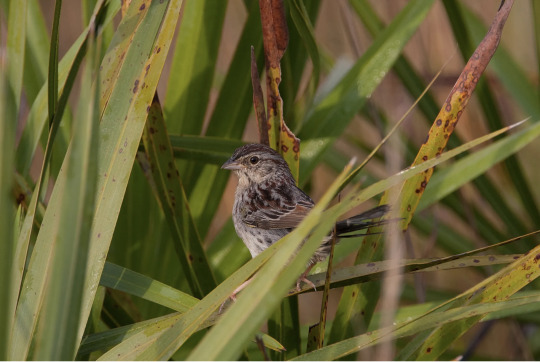#Charles (Buck) MacLaughlin
Text
Florida’s Vanishing Sparrows
A group of eccentric endangered birds serves as a bellwether of the climate crisis.
— By Dexter Filkins |July 17, 2023

The survival of the Florida grasshopper sparrow is in doubt, but the scientists who are working to help the species refuse to give up.Photograph from Nature Picture Library/Alamy
The Avon Park Air Force Range, in central Florida, is a noisy place. Most weeks, American pilots practice dropping bombs and firing rockets there, turning old Humvees into clouds of scrap metal and smoke. Last month, a crowd gathered at the range to listen for the song of the Florida grasshopper sparrow—a faint chittering noise that evokes an insect’s buzz, giving the bird its name. As the crowd looked on expectantly, a group of tiny birds, small enough to fit in your palm, ventured tentatively from a pen, looked into the sunshine, and then flew away. The grasshopper sparrow, a modest and eccentric creature that inhabits the prairies of the central and southern parts of the state, is considered the most endangered bird in the continental United States. The birds at the bombing range were part of a program to bring their species back from the brink. “It will be hard, but we think this sparrow is worth saving,” Angela Tringali, a researcher at Archbold Biological Station, which is involved in the effort, told me.
With its subtropical climate, Florida hosts a vast array of wildlife that exists nowhere else in the county. But years of relentless human population growth have driven many to the vanishing point: Florida is home to sixty-seven species of threatened and endangered animals, among the highest numbers in the continental U.S. Those include the Miami blue butterfly, the Everglade snail kite, and the Florida panther, of which fewer than two hundred and fifty remain.
Birds that nest on or near the ground—like the Cape Sable seaside sparrow and the grasshopper sparrow—are especially vulnerable. Grasshopper sparrows can fly, but they spend most of their lives on the ground, nesting in clumps of tall grass. This provides easy access to the insects that they eat (though it also makes them susceptible to predators, like skunks and snakes). As more and more people moved to Florida, their habitat—in the prairies that used to cover much of the state south of Orlando—gave way to shopping centers and housing tracts.
For decades, scientists watched the sparrows’ numbers slowly ebb. In 1986, the U.S. Fish and Wildlife Service declared them endangered; by the end of the century, there were thought to be fewer than a thousand left. Shortly after that, the population began dropping precipitously, and by 2012 as few as seventy-five males remained. Beyond habitat loss, the reasons for the steep decline weren’t entirely clear, though some scientists suspected fire ants, an invasive species. “We started to panic,” Mary Peterson, an endangered species biologist with the U.S. Fish and Wildlife Service, said.
As the sparrows approached extinction, Peterson and other scientists decided that they couldn’t risk letting the bird continue to breed only in the wild. After identifying three concentrations of birds in protected habitats, and one on a private ranch, they gathered what adults they could and began breeding them in captivity around the state. Captive breeding is generally considered a last resort—some species of birds and other animals don’t survive it. But, Peterson said, “the risk of not doing anything could be catastrophic.” The scientists released their first batch of youngsters, a dozen birds, in 2019. Since then, they have bred and released more than seven hundred. In a good year, about a quarter of the chicks survive to adulthood in the wild; the release at the Avon Park bombing range last week brought the estimated number of birds to about two hundred and fifty.
The Avon Park range appears to be an especially promising venue for the birds. With more than a hundred thousand acres, it contains more than a dozen other threatened and endangered species. Twenty years ago, before populations collapsed, it was home to about three hundred grasshopper sparrows. The Department of Defense has proved to be an eager partner in preservation: Charles (Buck) MacLaughlin, the range operations officer, told me that the Air Force and the Fish and Wildlife Service periodically survey the landscape, when there aren’t air strikes scheduled. “I don’t think any have been killed there,” he told me.
Still, the survival of the grasshopper sparrow is in doubt. “Extinction is still a possibility,” Peterson said. The scientists aim to create ten protected sites of at least fifty breeding pairs each—a goal that is many years away, at best. The challenge is less in breeding sufficient numbers than in finding space for them; some ninety per cent of the bird’s historic habitat is gone. There are similar stories throughout the state. The Florida panther is making a modest comeback, but it’s constrained by human presence in the Everglades; last year, some twenty-five panthers were killed by cars. In the oceans off the coast, temperatures of ninety-plus degrees threaten coral reefs. But the scientists who are working to help the grasshopper sparrow refuse to give up. Tringali, the biologist, told me, “It’s really easy to do nothing. We are not done. We have a long way to go.” ♦
#Birds | Endangered Species | Florida | Environmentalism#The New Yorker#Dexter Filkins#The Avon Park Air Force Range#The Continental United States 🇺🇸#Angela Tringali#Archbold Biological Station#Miami Blue Butterfly | The Everglade Snail Kite | The Florida Panther#Orlando#U.S. Fish and Wildlife Service#Mary Peterson#Extinction#Charles (Buck) MacLaughlin#Air Force
3 notes
·
View notes